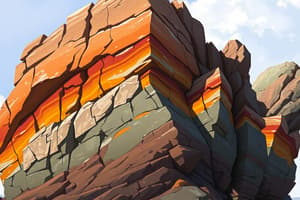Podcast
Questions and Answers
What two characteristics are used to classify igneous rocks?
What two characteristics are used to classify igneous rocks?
Texture and composition
Igneous rocks with large crystals exhibit a ______ texture.
Igneous rocks with large crystals exhibit a ______ texture.
coarse-grained
What kind of texture do igneous rocks exhibit when they cool rapidly?
What kind of texture do igneous rocks exhibit when they cool rapidly?
- Fine-grained Texture (correct)
- Glassy Texture
- Coarse-grained Texture
- Porphyritic Texture
What is an example of a rock with a glassy texture?
What is an example of a rock with a glassy texture?
Rocks that have a ______ composition are typically darker and denser than granitic rocks.
Rocks that have a ______ composition are typically darker and denser than granitic rocks.
What is the main mineral composition of granitic rocks?
What is the main mineral composition of granitic rocks?
Match the following compositional groups with their characteristics:
Match the following compositional groups with their characteristics:
Porphyritic texture results from minerals crystallizing at the same rate.
Porphyritic texture results from minerals crystallizing at the same rate.
What is the common volcanic rock associated with andesitic composition?
What is the common volcanic rock associated with andesitic composition?
Flashcards are hidden until you start studying
Study Notes
Classification of Igneous Rocks
- Igneous rocks are classified by texture and composition.
- Texture refers to appearance regarding crystal size, shape, and arrangement.
- Composition classification is based on the proportion of light (silicate) and dark minerals.
Coarse-Grained Texture
- Slow cooling of magma leads to the formation of large crystals.
- This process allows ions to move long distances within the magma.
- Rocks with this texture display a coarse-grained appearance due to substantial crystal sizes.
Fine-Grained Texture
- Rapid cooling of magma or lava results in small, interconnected mineral grains.
- Ions in quickly cooled magma lose motion, promoting fast mineral formation.
- The competition for available ions creates a large number of tiny crystals.
Glassy Texture
- Rapid cooling of lava on the Earth's surface prevents crystallization.
- Resulting rocks consist of randomly distributed ions instead of crystalline structures.
- Obsidian and pumice are prime examples of rocks with a glassy texture.
Porphyritic Texture
- Crystals in magma crystallize at different rates, leading to varied sizes.
- Larger crystals, known as phenocrysts, can form before smaller crystals.
- This texture features large and small minerals due to different cooling rates.
Granitic Composition
- Granitic rocks are predominantly composed of light-colored silicate minerals like quartz and feldspar.
- They contain about 70% silica and are prevalent in continental crust.
- Rhyolite is an example of an extrusive granitic rock.
Basaltic Composition
- Basaltic rocks are rich in dark silicate minerals and plagioclase feldspar.
- These rocks contain high levels of magnesium and iron, making them darker and denser.
- Basalt is the most common basaltic rock, while gabbro is its intrusive equivalent.
Other Compositional Groups
- Andesitic composition represents a blend between granitic and basaltic rocks, named after andesite.
- Peridotite, a significant igneous rock, consists mainly of olivine and pyroxene.
- Classified as ultramafic, peridotite is primarily made of dark silicate minerals.
Studying That Suits You
Use AI to generate personalized quizzes and flashcards to suit your learning preferences.




